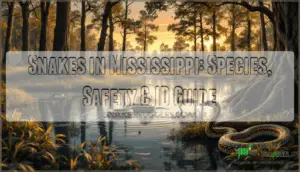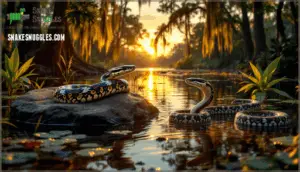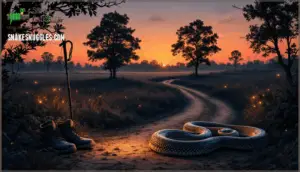This site is supported by our readers. We may earn a commission, at no cost to you, if you purchase through links.

These reptiles aren’t the villains of backyard folklore; they’re skilled predators that control rodent populations and anchor the food webs that keep Mississippi’s ecosystems balanced.
Whether you’re hiking through longleaf pine forests, wading in coastal marshes, or simply living in snake country, understanding which species share your landscape—and how they actually behave—transforms fear into informed coexistence. The difference between a timber rattlesnake and a harmless rat snake could mean the difference between unnecessary panic and genuine safety awareness.
Table Of Contents
- Key Takeaways
- Snake Diversity in Mississippi
- Identifying Mississippi Snakes
- Snake Habitats Across Mississippi
- Snake Behavior, Diet, and Hunting
- Snake Safety, Bites, and Conservation
- Frequently Asked Questions (FAQs)
- Are there poisonous snakes in Mississippi?
- How many snakes are in Mississippi?
- What snakes live in Mississippi?
- Are there rattlesnakes in Mississippi?
- What are the most common water snakes in Mississippi?
- What is the largest venomous snake in Mississippi?
- What is the most common snake in Mississippi?
- What are the tiny brown snakes in Mississippi?
- What kind of snake is black with white spots in Mississippi?
- Where are rattlesnakes in MS?
- Conclusion
Key Takeaways
- Mississippi’s 55 snake species include only six venomous pit vipers—copperheads, cottonmouths, and three rattlesnake species—while the remaining 49 harmless species control rodent populations and maintain ecosystem balance across diverse habitats from coastal marshes to pine forests.
- Snake identification relies on observable physical markers like triangular versus tapered head shapes, distinctive color patterns (copperhead hourglasses, water snake reticulation), and behavioral cues such as ambush versus active hunting strategies, enabling you to distinguish venomous from nonvenomous species confidently.
- Despite Mississippi recording approximately 236 venomous snakebites annually with copperheads responsible for 27% of cases, zero documented deaths have occurred in the past two decades, demonstrating that bites remain defensive responses rather than predatory aggression when humans give snakes appropriate space.
- Conservation efforts combining habitat preservation, regulated collection enforcement, and community education programs reduce unnecessary snake killings while protecting two federally endangered species—the extirpated eastern indigo snake and the critically declining black pine snake confined to isolated longleaf pine forest populations.
Snake Diversity in Mississippi
Mississippi is home to an impressive variety of snakes, each adapted to thrive in the state’s diverse ecosystems—from coastal marshes to pine forests and swamps.
You’ll encounter species ranging from harmless garter snakes to the state’s six venomous serpents, along with a few specialized species that you’re unlikely to cross paths with.
Understanding what snakes inhabit your region will help you identify them correctly and know which ones warrant caution.
Common Non-Venomous Snakes
Mississippi’s non-venomous snakes represent the majority of the state’s serpentine residents, and they’re far more likely to be your neighbor than any of the handful of venomous species that also call the state home.
These harmless species play vital roles in local ecosystems, controlling rodent populations and serving as prey for larger predators. Common nonvenomous snakes you’ll encounter include:
- Garter snakes—slender, striped reptiles that thrive in wetlands and grasslands
- King snakes—sturdy constrictors that actively hunt other snakes and small mammals
- Rat snakes—excellent climbers found in forests and agricultural areas
- Water snakes—semi-aquatic hunters in rivers, swamps, and coastal habitats
- Hognose snakes—soil-dwelling species with specialized digging adaptations
Understanding snake diversity and nonvenomous behavior helps you coexist safely with these beneficial reptiles during wild encounters.
Venomous Snake Species
While the vast majority of Mississippi’s snakes pose no threat to humans, the state is home to a small but significant group of venomous species that deserve your respect and understanding rather than fear. Mississippi harbors six venomous snake species, all pit vipers—a family distinguished by heat-sensing pits between their eyes and nostrils. These include three rattlesnake species and three non-rattling pit vipers.
Their venom delivery systems inject potent snake toxins designed to immobilize prey, though antivenom treatment remains highly effective for human bites. Recognizing bite symptoms like swelling and discoloration facilitates prompt medical intervention, while venom resistance varies among potential prey species.
Snake identification skills—noting triangular heads and characteristic patterns—help you avoid defensive encounters entirely.
Protected and Rare Snakes
Beyond the venomous pit vipers, Mississippi harbors two federally protected species facing extinction-level threats. The eastern indigo snake, once widespread throughout the state, hasn’t been confirmed in decades and is presumed extirpated—though reintroduction efforts in neighboring states show promise.
The black pine snake, now confined to just 6-10 isolated populations in longleaf pine forests, has declined over 50% since the early 2000s due to habitat loss and fire suppression.
These rare species exemplify why habitat preservation and snake conservation matter profoundly for wildlife protection and ecological balance.
Identifying Mississippi Snakes
Identifying snakes in Mississippi doesn’t require you to be an expert—just knowing a few key features will get you where you need to be. The most reliable way to tell species apart is by looking at their patterns, coloration, head shape, and body size, combined with observing how they behave.
Below, we’ll walk you through each of these identifying markers so you can confidently recognize the snakes you encounter.
Patterns and Coloration
Mississippi’s snake species display striking color morphs and scale patterns that serve as your primary identification tools. Dorsal stripes, blotches, and bands reflect each species’ camouflage techniques and ecological adaptation.
The reticulated pattern of water snakes, the characteristic hourglass markings of copperheads, and the checkered belly texture of garter snakes reveal distinct reptilian biology.
These snake markings and texture variations—from keeled scales creating ridged surfaces to smooth, glossy integument—directly correlate with habitat preference and behavioral strategy, making visual assessment essential for field identification.
Head Shape and Body Size
The head’s architecture—whether broad and triangular or slender and tapered—acts as nature’s blueprint for predicting both a snake’s venom status and its hunting strategy in Mississippi’s diverse ecosystems. Venomous species like rattlesnakes and cottonmouths display distinctly triangular heads housing venom-delivery apparatus, while nonvenomous snakes feature narrower, more tapered craniums.
Body length varies dramatically across reptiles: garter snakes rarely exceed three feet, whereas rat snakes and water snakes routinely reach five to six feet. These snake proportions—combined with scale patterns and head morphology—enable confident field identification in your region.
Behavioral Traits
Watch how a snake moves, and you’ll quickly discover whether it’s hunting or merely passing through your yard—behavior often reveals as much about a species’ identity as its physical markings. Mississippi’s serpents display distinct behavioral signatures that aid identification:
- Hunting Strategies vary: venomous snakes often employ ambush tactics, while nonvenomous species actively pursue prey.
- Social Interactions differ; most snakes are solitary except during mating rituals.
- Territorial Marking through scent trails helps distinguish resident versus transient individuals.
- Escape Mechanisms range from rapid flight to defensive displays—cottonmouths gape their pale mouths, while rat snakes vibrate their tails.
- Mating Rituals involve pheromone-tracking behaviors unique to each species.
These behavioral cues complement physical characteristics, enabling precise reptile diversity and behavior assessment in your region.
Snake Habitats Across Mississippi
Mississippi’s diverse landscape creates distinct ecological zones where different snake species thrive, each suited to its particular environment. Understanding where snakes live across the state helps you recognize which species you’re likely to encounter and how to coexist safely with them.
Here’s what you’ll find in each major habitat type.
Forests and Woodlands
Mississippi’s forests and woodlands create ideal microhabitats where you’ll encounter the state’s most abundant and behaviorally diverse snake species. Beneath the deciduous canopy, timber snakes like rat snakes and king snakes thrive on forest floors rich with leaf litter and prey.
The woodland ecology fosters remarkable reptile diversity—from harmless species sheltering in rotting logs to venomous copperheads and cottonmouths inhabiting tree canopy margins. This snake habitat represents a critical zone for wildlife conservation, where species composition shifts with canopy density and understory vegetation complexity.
Swamps, Wetlands, and Rivers
Where Mississippi’s terrestrial snakes give way to water, you’ll discover an entirely different cast of reptiles—species so specialized for aquatic life that they’ve fundamentally transformed their anatomy and behavior to thrive in swamps, wetlands, and rivers. These aquatic snake species represent critical components of freshwater ecology, with water snakes and cottonmouths dominating these wetland ecosystems.
Consider these key inhabitants:
- Water snakes exhibit flattened tails and laterally compressed bodies enabling efficient swimming through riverine habitats.
- Cottonmouths (venomous pit vipers) possess heat-sensing pits along their jaws for detecting aquatic prey in murky conditions.
- Mud snakes burrow in swamp substrates, hunting for aquatic amphibians and fish larvae.
- Ribbon snakes remain semi-aquatic, patrolling wetland margins with exceptional agility.
- Green water snakes display specialized respiratory adaptations for prolonged submersion in stagnant swamp water.
These reptile diversity patterns reflect swamp conservation priorities, as wetland degradation threatens snake habitats throughout Mississippi’s critical ecological zones.
Grasslands, Farmland, and Suburban Areas
These open landscapes host grassland specialists like racer snakes and rat snakes, which hunt rodents across fields and pastures. Garter snakes thrive in farmland margins, exploiting agricultural rodent populations.
Habitat modification—plowing, pesticide use, and development—fundamentally alters snake migration corridors and grassland biodiversity. Suburban expansion fragments habitats, concentrating some venomous species like copperheads near human structures.
Understanding grassland ecology helps you identify snakes in these zones and implement wildlife management strategies protecting both reptiles and livestock.
Snake Behavior, Diet, and Hunting
Understanding how Mississippi’s snakes behave and hunt gives you vital insight into why you’ll encounter them in certain places and times.
Most snakes spend their days resting and regulating their body temperature, but they’re opportunistic hunters when the moment calls for it.
Whether they’re stalking small mammals, ambushing fish in water, or waiting for passing prey, their hunting strategies vary widely depending on the species and environment.
Typical Activity Patterns
Most snakes in Mississippi spend their time in a state of relative stillness, waiting rather than wandering—a strategy that conserves energy while positioning them perfectly for their next meal. Their daily routines revolve around thermoregulation and opportunistic hunting.
Many species exhibit nocturnal behavior, becoming active during cooler evenings when temperatures favor hunting efficiency. Activity cycles vary by season; spring and fall see increased movement as snakes prepare for breeding or hibernation.
This passive hunting strategy—remaining motionless for extended periods—defines snake behavior across Mississippi’s diverse ecosystems and snake species.
Diet: Mammals, Fish, Amphibians, and More
What your Mississippi snakes eat depends entirely on their size, hunting strategy, and the prey available in their particular habitat—and understanding these dietary preferences reveals just how specialized these predators have become. Snake species exhibit remarkably diverse feeding habits shaped by their reptile biology and position within food chains.
- Small snakes (garter snakes, ring-necks) consume invertebrates, amphibians, and small fish through active foraging
- Medium snakes (rat snakes, water snakes) target rodents, frogs, and fish, playing critical roles in nutrient cycling
- Large constrictors (pythons) consume mammals up to rabbit size via prey capture and constriction
- Venomous snakes (cottonmouths, copperheads) use venom to immobilize prey ranging from small mammals to amphibians
This dietary diversity drives snake behavior and maintains ecological balance across Mississippi’s ecosystems.
How Snakes Hunt and Feed
The mechanics of predation in your local snakes reveal a fascinating interplay between sensory sophistication and strike precision. Each species has evolved specialized hunting strategies finely tuned to their prey preferences and ecological niche.
Venomous snakes deploy ambush tactics, waiting motionless until prey ventures within striking distance, then delivering neurotoxins or hemotoxins to immobilize victims before consumption. Nonvenomous constrictors employ different prey capture methods, coiling around rodents to restrict movement. Water snakes actively forage, pursuing fish through aquatic environments. Smaller species use persistence hunting, tracking prey through leaf litter.
These divergent feeding habits and strike techniques reflect millions of years of evolutionary refinement, allowing Mississippi’s snake species to exploit distinct ecological niches while maintaining predatory efficiency.
Snake Safety, Bites, and Conservation
Understanding snake safety in Mississippi means knowing how to prevent bites, respond if one occurs, and support the species that share your landscape. Whether you encounter a snake in your yard or on a trail, the right knowledge transforms fear into respect—and keeps both you and the snake safer.
Below, we’ll walk through the essential information you need: bite statistics and prevention strategies, immediate first aid steps, and how conservation efforts protect these often-misunderstood reptiles.
Snakebite Statistics and Prevention
Venomous snakebites in Mississippi remain statistically uncommon despite the presence of six venomous species. The state records approximately 236 annual bites, with copperheads accounting for 27% of reported cases. Your risk peaks March through October, particularly in forested and wetland habitats. Fortunately, fatalities are virtually nonexistent—no confirmed deaths since 2000.
Bite prevention hinges on risk assessment through proper snake identification and classification, wearing protective clothing, avoiding deliberate touching, and maintaining awareness in snake-prone environments. Understanding venom research findings helps contextualize that most bites represent defensive responses, not predatory aggression.
Snake conservation and threats awareness underscores why giving snakes space constitutes your most effective safety strategy. For more information on snake bite trends, review the snake bite statistics to better understand the risks.
First Aid and Treatment for Bites
If you’ve been bitten, the first moments matter far more than you might think—knowing what to do (and what not to do) can make a real difference in your outcome. Immediate wound cleaning with soap and water reduces infection risk, while immobilizing the bitten limb slows venom circulation. Remove constrictive items like rings or bracelets.
Don’t attempt venom extraction or apply tourniquets—these worsen tissue damage. Seek emergency response immediately, especially if bite symptoms like swelling, discoloration, or systemic effects emerge.
Antivenom administration at medical facilities remains your definitive treatment for venomous snake bites. Transport safely without unnecessary movement; call 911 rather than driving yourself.
Conservation Efforts and Education
Protecting Mississippi’s snakes requires coordinated habitat preservation and community engagement. State wildlife agencies manage protected species through regulated habitat conservation and enforce regulations against unauthorized collection. Snake research programs at universities advance herpetology understanding, while education initiatives combat misconceptions through public outreach.
Community-based wildlife education programs teach coexistence strategies, reducing unnecessary killings. These conservation efforts recognize that snakes maintain ecological balance—controlling rodent populations and supporting ecosystem health. Your participation in habitat stewardship and wildlife awareness directly sustains snake populations’ long-term survival. Effective wildlife education programs are vital for promoting coexistence with snakes and other wildlife.
Frequently Asked Questions (FAQs)
Are there poisonous snakes in Mississippi?
Only about 11 percent of Mississippi’s 55 snake species are venomous—just six species. You’ll encounter pit vipers like copperheads, cottonmouths, and rattlesnakes, plus the eastern coral snake.
Despite their potent venom, snake encounters rarely prove fatal in Mississippi. Knowing your venomous snakes and practicing simple precautions keeps you safe.
How many snakes are in Mississippi?
Around 50 to 55 snake species inhabit Mississippi, representing substantial reptile diversity for the region. Only six of these species are venomous, meaning the vast majority pose no threat.
This snake diversity reflects Mississippi’s varied regional ecology—from swampland to forests—supporting widespread snake distribution across the state’s diverse habitats.
What snakes live in Mississippi?
Your state’s reptile diversity presents a fascinating ecosystem where fifty-five snake species slither through Mississippi’s varied habitats—no boa constrictor here, just natural residents. Only six are venomous, while the rest pose no threat, including kingsnakes, rat snakes, and water snakes.
Regional distribution encompasses garter snakes, whipsnakes, and racers, reflecting the rich snake species diversity across USA ecosystems and wildlife conservation priorities.
Are there rattlesnakes in Mississippi?
Yes, rattlesnakes inhabit Mississippi. You’ll encounter three venomous species: the Western Diamond-backed Rattlesnake, Eastern Massasauga, and Timber Rattlesnake.
These viperids occupy diverse habitats—forests, grasslands, and swamps—where their distinctive triangular heads and rattling tails serve as reliable identification features and defensive warnings.
What are the most common water snakes in Mississippi?
Water snakes dominate Mississippi’s freshwater ecosystems, with the Northern Water Snake being most abundant. You’ll also encounter Cottonmouths in these aquatic habitats—though venomous, they’re generally docile.
Both species hunt fish and amphibians in wetlands and rivers.
What is the largest venomous snake in Mississippi?
The eastern cottonmouth ranks as Mississippi’s largest venomous snake, reaching lengths up to five feet.
This pit viper inhabits swamps and wetlands throughout the state, delivering hemotoxic venom through its distinctive heat-sensing pits and triangular head.
What is the most common snake in Mississippi?
The garter snake ranks among Mississippi’s most prevalent species, thriving across the state’s diverse habitats from wetlands to suburban areas.
Their adaptability, coupled with their non-venomous nature and varied regional distributions, establishes them as exceptionally common throughout Mississippi’s snake species diversity.
What are the tiny brown snakes in Mississippi?
DeKay’s Brownsnake might be the diminutive reptile you’ve encountered—this secretive species rarely exceeds twelve inches in length.
Frequently observed beneath debris or landscape materials in suburban Mississippi habitats, these tiny species exhibit cryptic brown coloration with paired dorsal spots, contributing to outstanding snake species diversity across the USA’s southeastern region.
What kind of snake is black with white spots in Mississippi?
A black snake with white spots in Mississippi could be the speckled kingsnake (Lampropeltis holbrooki), a non-venomous species. Pattern recognition aids Snake Identification—this species shows distinctive white or yellowish spotting across dark scales.
Mississippi Wildlife includes this docile constrictor, which hunts venomous snakes and exhibits fascinating Snake behavior among Black Snake Varieties statewide.
Where are rattlesnakes in MS?
Rattlesnakes inhabit diverse Mississippi terrain—from pine savannas and forests to swamps and agricultural fields.
You’ll find timber rattlesnakes statewide, while eastern diamondbacks occupy southern counties near pine savanna habitats and MS wildlife areas.
Conclusion
Consider that Mississippi harbors zero documented deaths from wild snake encounters in the past two decades—a demonstration of how rarely these animals initiate conflict.
Your knowledge of snakes in Mississippi transforms them from imagined threats into observable neighbors. When you distinguish a coachwhip’s speed from a cottonmouth’s deliberate movement, you’re applying herpetological literacy that protects both species and people.
The swamps aren’t menacing; they’re simply occupied by animals doing what evolution designed them to do.












